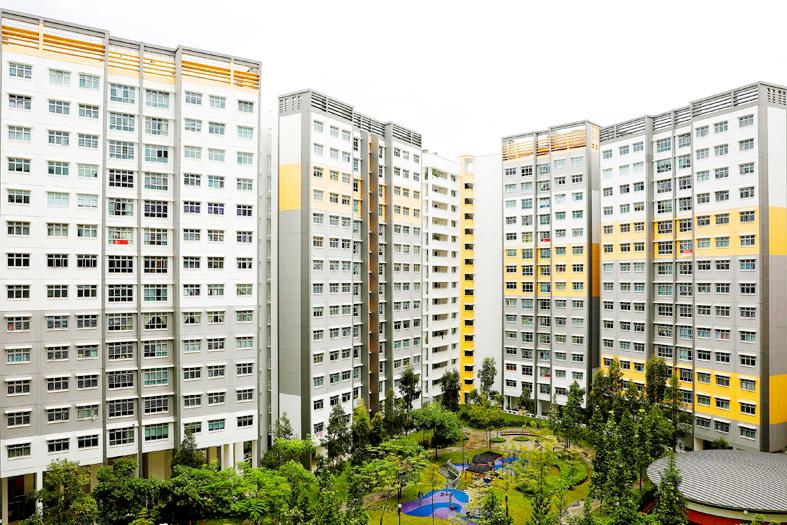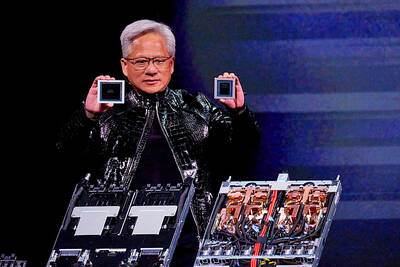Singapore has introduced residential property curbs for the first time since 2018 to cool a surge in home prices over the past year.
The steps include raising additional stamp duties for second-home buyers and foreigners purchasing private property, as well as tightening loan limits for public housing apartments.
Developers would also have to pay higher stamp duties of 35 percent, up from 25 percent, when purchasing residential projects. They can claw back this amount if they sell all units within five years of purchasing the site, but there is an extra 5 percent that cannot be refunded under a requirement introduced in the last round of cooling measures in 2018.

Photo: Reuters
The Singaporean government would also increase the supply of public and private housing, the Singaporean ministries of finance and national development, and the Monetary Authority of Singapore said in a joint statement late on Wednesday.
Buyers have been capitalizing on low interest rates and expectations that prices would climb further as the economy recovers.
That has led to rising property prices even as Singapore implemented stop-start COVID-19 restrictions for several months, which limited viewings of new homes and deterred developers from launching projects.
The government has decided to act now to “reduce the risk of a self-reinforcing cycle of price increases” that would affect affordability in the private and public housing markets, Singaporean Minister for National Development Desmond Lee (李智陞) told a briefing with local media as reported by the Straits Times.
“Left unchecked, prices are likely to run ahead of economic fundamentals,” Lee was quoted as saying. “This will increase the risk of a destabilizing correction later on that will hurt many households.”
Borrowers would be vulnerable to a likely rise in interest rates next year and beyond given that major central banks are looking to tighten monetary policy, Lee said.
The central bank issued a similar warning earlier this month, saying that household debt is higher than pre-COVID-19 levels, driven by property loans.
As such, leverage risk has grown, the central bank said.
Private home prices have risen by about 9 percent since the first quarter of last year, the statement said.
The secondary market for public housing is also recovering sharply after a six-year decline, rising about 15 percent over that period.
There were S$32.9 billion (US$24.1 billion) in sales in the first half of this year, double what was recorded in Manhattan, New York, driven by demand from the ultra-rich flocking to the business hub.
Government officials have long cautioned that low rates can distort asset prices and the property market should not run ahead of economic fundamentals.
Still, the latest announcement came as a surprise given that the central bank in June said that the market is not overheating.
“The measures undertaken in this cooling package will help promote a stable and sustainable property market,” the statement said. “The government remains vigilant to the risk of a sustained increase in prices relative to income trends.”
The new property curbs, especially higher land taxes, would place “immense additional pressure” on developers trying to recover from the COVID-19 pandemic, an industry group said.
“The recalibrated tough measures are rather unexpected in view that the property market is just beginning to emerge from the challenging COVID-19 situation,” the Real Estate Developers’ Association of Singapore said yesterday in an e-mailed statement. “Significant uncertainties still persist.”
As a result, the group is pleading for some leeway.
“The property market should be allowed a bit more time to recover and reach a sustained equilibrium,” it said.

Nvidia Corp chief executive officer Jensen Huang (黃仁勳) on Monday introduced the company’s latest supercomputer platform, featuring six new chips made by Taiwan Semiconductor Manufacturing Co (TSMC, 台積電), saying that it is now “in full production.” “If Vera Rubin is going to be in time for this year, it must be in production by now, and so, today I can tell you that Vera Rubin is in full production,” Huang said during his keynote speech at CES in Las Vegas. The rollout of six concurrent chips for Vera Rubin — the company’s next-generation artificial intelligence (AI) computing platform — marks a strategic

Shares in Taiwan closed at a new high yesterday, the first trading day of the new year, as contract chipmaker Taiwan Semiconductor Manufacturing Co (TSMC, 台積電) continued to break records amid an artificial intelligence (AI) boom, dealers said. The TAIEX closed up 386.21 points, or 1.33 percent, at 29,349.81, with turnover totaling NT$648.844 billion (US$20.65 billion). “Judging from a stronger Taiwan dollar against the US dollar, I think foreign institutional investors returned from the holidays and brought funds into the local market,” Concord Securities Co (康和證券) analyst Kerry Huang (黃志祺) said. “Foreign investors just rebuilt their positions with TSMC as their top target,

REVENUE PERFORMANCE: Cloud and network products, and electronic components saw strong increases, while smart consumer electronics and computing products fell Hon Hai Precision Industry Co (鴻海精密) yesterday posted 26.51 percent quarterly growth in revenue for last quarter to NT$2.6 trillion (US$82.44 billion), the strongest on record for the period and above expectations, but the company forecast a slight revenue dip this quarter due to seasonal factors. On an annual basis, revenue last quarter grew 22.07 percent, the company said. Analysts on average estimated about NT$2.4 trillion increase. Hon Hai, which assembles servers for Nvidia Corp and iPhones for Apple Inc, is expanding its capacity in the US, adding artificial intelligence (AI) server production in Wisconsin and Texas, where it operates established campuses. This

US President Donald Trump on Friday blocked US photonics firm HieFo Corp’s US$3 million acquisition of assets in New Jersey-based aerospace and defense specialist Emcore Corp, citing national security and China-related concerns. In an order released by the White House, Trump said HieFo was “controlled by a citizen of the People’s Republic of China” and that its 2024 acquisition of Emcore’s businesses led the US president to believe that it might “take action that threatens to impair the national security of the United States.” The order did not name the person or detail Trump’s concerns. “The Transaction is hereby prohibited,”